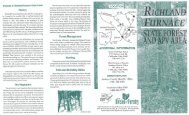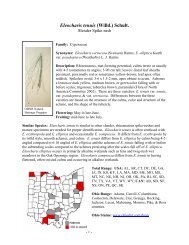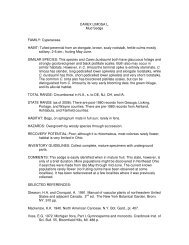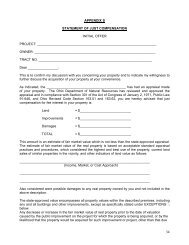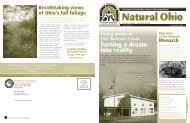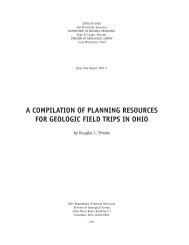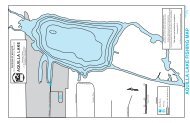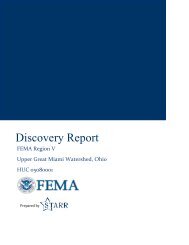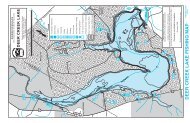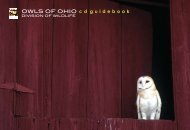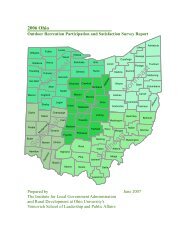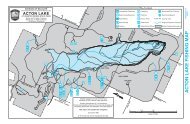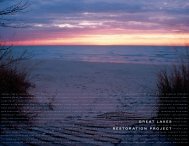Pasture/Hayland Management for Wildlife and Livestock
Pasture/Hayland Management for Wildlife and Livestock
Pasture/Hayland Management for Wildlife and Livestock
Create successful ePaper yourself
Turn your PDF publications into a flip-book with our unique Google optimized e-Paper software.
How do you set up a rotational<br />
pasture<br />
Divide the management area into at least four<br />
fenced paddocks, including warm-season grass paddocks<br />
planted to switch grass (Blackwell variety),<br />
mixed big bluestem (Roundtree variety)/Indiangrass<br />
(Rumsey variety), Eastern gamagrass <strong>and</strong> a coolseason<br />
grasses paddock planted to a combination of<br />
bluegrass, orchardgrass <strong>and</strong> timothy. Refer to Figure<br />
2 <strong>for</strong> an example.<br />
In<strong>for</strong>mation on planting methods, seeding rates<br />
etc., <strong>for</strong> prairie grasses can be obtained in the Prairie<br />
Grassl<strong>and</strong> Habitat <strong>Management</strong> publication. Cool season<br />
grass establishment in<strong>for</strong>mation can be obtained<br />
by contacting your County Cooperative Agricultural<br />
Extension Agent.<br />
<strong>Management</strong> Guidelines <strong>for</strong><br />
Grazing Paddocks<br />
1. Do not graze newly planted prairie grass st<strong>and</strong>s<br />
until two years after establishment.<br />
2. The optimum time to graze in order to maximize<br />
use of <strong>for</strong>age is when the grasses are in the “boot<br />
stage” of development. The “boot stage” occurs<br />
when the seed heads are within the sheath of the<br />
grass stem.<br />
3. Do not start grazing prairie grasses until they are<br />
at least 12” to 18” high.<br />
4. Remove livestock when grass height reaches 6”<br />
to 8”.<br />
5. Do not graze any of the prairie paddocks later than<br />
September 15.<br />
6. Do not overgraze!<br />
<strong>Management</strong> Guidelines <strong>for</strong><br />
<strong>Hayl<strong>and</strong></strong> Paddock<br />
1. Do not harvest hay on newly planted prairie grass<br />
until two years after establishment.<br />
2. Mixed plantings are the best <strong>for</strong> the prairie hayl<strong>and</strong><br />
paddock such as a combination of Indiangrass<br />
<strong>and</strong> the legume - bush clover. Legumes such<br />
as partridge pea <strong>and</strong> Illinois bundleflower are also<br />
suitable to plant with grasses <strong>for</strong> hay.<br />
3. Big bluestem <strong>and</strong> Indiangrass can be harvested in<br />
late July / August 1. Eastern gamagrass should be<br />
harvested from early July to mid-July.<br />
4. Leave a 50’ wide uncut strip around the perimeter<br />
<strong>for</strong> nesting <strong>and</strong> brooding wildlife.<br />
5. Do not take more than one cutting of hay per<br />
year.<br />
6. Leave a 6” to 8” stubble when cutting <strong>for</strong> hay.<br />
<strong>Management</strong> Guidelines <strong>for</strong><br />
Refuge Paddock<br />
1. Do not hay or pasture refuge paddock annually.<br />
Refuge paddock is to be rested <strong>and</strong> provide undisturbed<br />
habitat <strong>for</strong> wildlife.<br />
2. Plant refuge paddock to a mixture of prairie<br />
grasses <strong>and</strong> flowers. Refer to Prairie Grassl<strong>and</strong><br />
Habitat <strong>Management</strong> publication <strong>for</strong> in<strong>for</strong>mation<br />
on species to include in this planting.<br />
3. Maintain prairie in refuge paddock by harvesting<br />
one cutting of hay every third year.<br />
NOTE: Long-term prairie pasture <strong>and</strong> hayl<strong>and</strong><br />
productivity can be enhanced by periodic fertilization.<br />
Nitrogen can be applied be<strong>for</strong>e grasses reach<br />
4-5 inches in the spring, apply 40-60lbs. of N/acre.<br />
Refer to Prairie Grassl<strong>and</strong> Habitat <strong>Management</strong><br />
publication <strong>for</strong> more in<strong>for</strong>mation on prairie maintenance.



